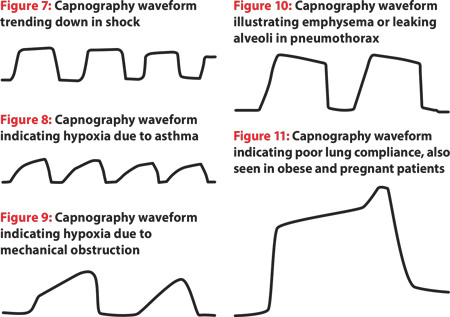- 呼出的二氧化碳量反映心輸出量和肺部血流量
- 氧氣飽和度和血氧飽和度能作為通氣指引
但與呼氣末二氧化碳的變化相較下, 其反應是不夠迅速和敏感
- pulse oximeter 對測量 SpO2 會有30-90秒的延遲
沒有插管的病人亦可監測 EtCO2
ETCO2 增加可能是二氣化碳堆積
ETCO2 下降可能是氣道阻塞氣出不來或不呼了
- 正常人的 End tidal CO2 大約在 35-43 mmHg (PaCO2)
大約會比動脈的CO2分壓低 2~5mmHg
代謝增加狀況下 : 發燒, 感染, 甲亢 → EtCO2 ↑
代謝減少狀況下 : 例如鎮靜, 低體溫 → EtCO2 ↓
- EtCO2突然上升
代謝率增加
要把惡性高體溫malignant hyperthermia放在心上
→ 治療要給 Dantrolene
→ 這樣的 EtCO2 上升, 儘管將呼吸速率調高也沒辦法改善
腹腔鏡手術時, 會打入CO2 → 手術中的 EtCO2 會偏高
CO2 retention : COPD, 通氣不足
- EtCO2突然下降
代謝率下降, 或是換氣的效率 ↓
Shock (灌流不足), 肺栓塞, 氣道堵塞, 管路漏氣, auto-PEEP, 代謝酸中毒, 過度換氣 都會讓 EtCO2 下降
- 無脈搏病人插管後監測 EtCO2, 如果 <10 mmHg 要改善 CPR 品質
如果突然 >40 mmHg 可能有 ROSC

- ETCO2 target :
> 20 mmHg during CPR
35-45 mmHg after ROSC

1. A slanting upslope can represent airway obstruction
(COPD, bronchospasm, blocked endotracheal tube)
2. In patients paralyzed with a neuromuscular blocker,
as the paralytic wears off they may try to breathe asynchronously against the ventilator,
producing a notch called a curare cleft.
3. Quantitative capnography during resuscitation can be very useful.
During CPR, there should be a visible waveform during high quality chest compressions;
its absence may indicate accidental esophageal intubation
4. A sudden loss is bad, as it means that the tube is fully obstructed
or disconnected or that there has been a sudden loss of circulation
5. You can also just simply tell is someone is hypo- or hyperventilating
http://sketchymedicine.com/2016/08/waveform-capnography/

4C 代表完美插管
4B 頂端 Irregular 代表插管有問題 : leaking cuff, supraglottic placement, ET tube in right mainstem bronchus

7 : Shock 使 organ perfusion 變差, EtCO2 會降
8 : classic "shark's fin" shape is indicative of obstructive diseases like asthma
Pulmonary Embolism : Low, rounded rectangle EtCO2 waveform
PE 會 hyperventilation, CO2 wash out 所以 waveform 變低合理
https://www.jems.com/articles/print/volume-42/issue-8/features/how-to-read-and-interpret-end-tidal-capnography-waveforms.html?c=1
若是病患需要靠 #FMV 或 #BIPAP 維持氧合及通氣
可用 #MainStream 的 capnography 接在 BVM 的 mask 和 bag 間
若用 #SideStream 的 Capnography (#LifeSenseII) 也可以用一樣的接法
但要有一個側管的接頭將二氣化碳抽給機器分析
但病人只用氣氣面罩給氧呢
如病人只是打個藥睡一下覺來復位肩脫臼
這時可以用一種類似 nasal cannula 的管子放在病人鼻孔
#SideStream 型式的ETCO2 capnography 會把管路中的CO2抽到機器作分析
這樣就可監視病患通氣的狀況, 增進病患的安全
所以沒有插管的病人也是可以監測ETCO2 !
https://www.facebook.com/theCatLab.org/videos/vb.266648970445156/439245439852174/?type=2&theater
https://thetinynotes.com/topic/275/%E9%BA%BB%E9%86%89%E4%B8%AD%E7%9A%84%E7%9B%A3%E6%B8%AC-etco2


 留言列表
留言列表


